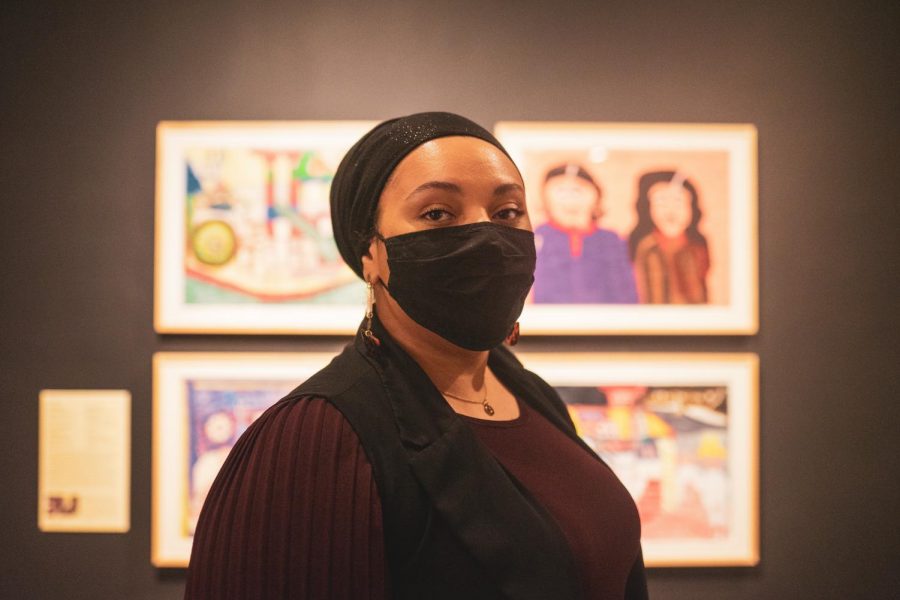When you step foot into the Cargill Gallery on the first floor of the Minneapolis Institute of Art (Mia), you will see an assortment of assemblages, quilts and works of found wood, metal, paint and more. The exhibition is impactful, it’s intentional and a University of Minnesota student curated it.
Curated by Starasea Nidiala Camara, Mia’s newest exhibition, “In the Presence of Our Ancestors: Southern Perspectives in African American Art,” will be open and free to view until December 2021.
The exhibition centers on past and present African American artists from the southern region of the United States.
Camara is a fourth-year student pursuing an individually designed interdepartmental major with concentrations in Arabic language and literature, African diaspora studies and art history. Camara’s opportunity came from the Souls Grown Deep Foundation, which annually selects three undergraduate students of color to work at museums across the country, including Mia. The foundation aims to diversify collections and the employment pipeline, affording undergraduates paid professional development within the museum field.
Camara grew up with art all around her — her mother is a lifelong artist — and at a young age, she cultivated a love for drawing and painting, eventually moving into welding, glasswork and ceramics as she got older.
“The first activity that was of interest to me was creating,” Camara said. She developed a curiosity for museum work in her midteens and worked at Mia as a visitor experience representative when she applied to the Souls Grown Deep internship program.
The exhibition features environmentally specific works using industrial materials like metal, wood and paint, Camara explained. For “Royal Flag” by Thornton Dial, Dial utilized paint, an American flag, a toy bull and a doll. Joe Minter’s “Old Rugged Cross” incorporates planks of wood and nails, and Lola Pettway made a quilt of corduroy, while Lottie Mooney’s quilt is cotton and rayon.
The exhibition walls are painted black, and each artistic work is accompanied by a label that informs the viewer of the artist’s background and provides a photo, giving the reader a further understanding of the artist’s life.
“I think that I very much wanted to create a specific ambiance, challenging the idea of a white cube gallery with works traditionally being presented without context, which is very common in the contemporary fashion in which galleries are often organized,” Camara said.
The opportunity to curate an exhibition as an undergraduate is rare, said Robert Cozzolino, curator of paintings at Mia. Cozzolino worked with Camara throughout the exhibition’s curatorial process.
Learning about curatorial work goes beyond the theoretical readings and exploration that happen within museum studies classrooms, Cozzolino said.
“The first thing that I found out when I started working in museums was there really isn’t a way to learn until you’re thrown in,” Cozzolino said. “I don’t know what happens in museum studies classes, but I know that if people are just talking theoretically about exhibitions, it doesn’t compare to the weird range of experiences and serendipitous events that happen when you’re actually dealing with the stuff and the people.”
Throughout the curatorial process, Camara sought out Mia’s Black, Indigenous and people of color Curatorial Advisory Committee (CAC), which helped her walk through layout choices like the nontraditional color of the walls and the labels that further explain the artists, among other programmatic elements of the show.
The work of the committee “horizontalized” the curatorial process, said Anniessa Antar, Mia activation specialist and CAC member.
“Bringing in other voices [for the committee] just helps kind of democratize the museum visitorship,” Antar said.
Antar said the committee is one component of a larger arc to develop more equitable museum practices.
“It’s a good start, but we need to also be looking at the structures, including payment, you know, just the general workplace culture and retention of people of color at the museum,” Antar said.
Camara explained that in some exhibition work, the communities that the exhibition is about are not always brought into the conversation or do not have agency over the work presented about them.
“The arts is a center of education — the arts is a pillar of education — but it’s also a methodology that can be applied to representation,” Camara said. “So if we’re not a part of these conversations — if we’re not leading these conversations — it’s not necessarily about being invited. It’s about being a part of the conversation from the beginning, contributing and working together to develop something new, something that’s beneficial to everybody. If we win, everybody wins.”




















Rohn
Feb 7, 2021 at 1:44 pm
I did not see posting of current exhibits (temp.). I think they should be poster at the top of site stuff. And; change text type to a brown color. The light gray is to faint for older folk to read.